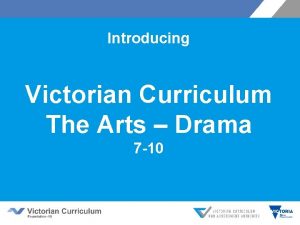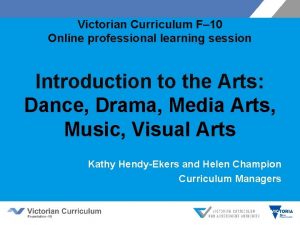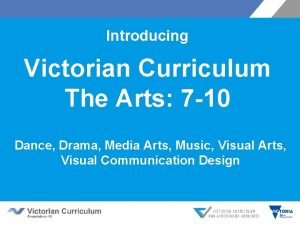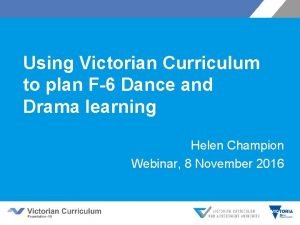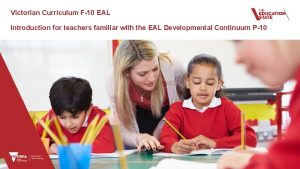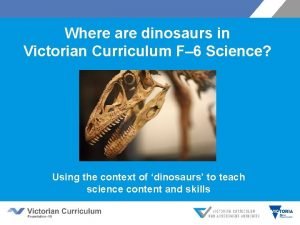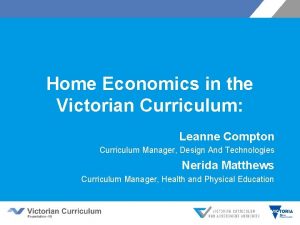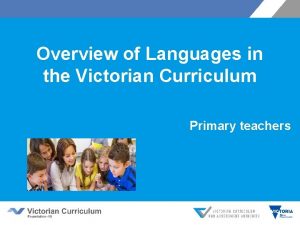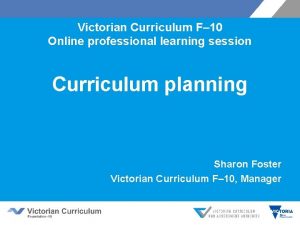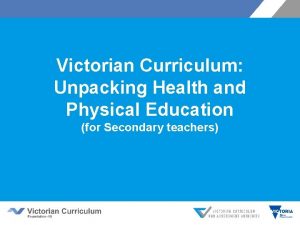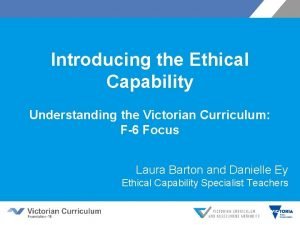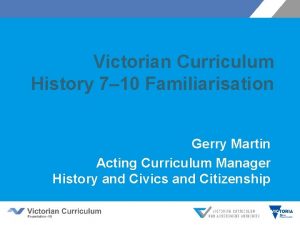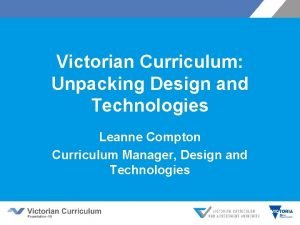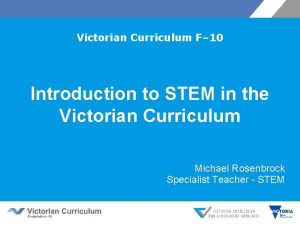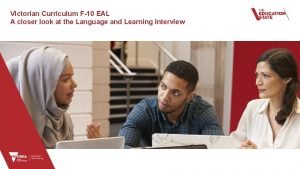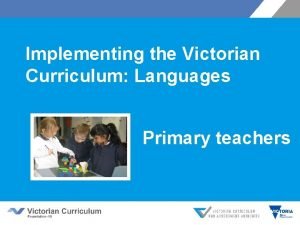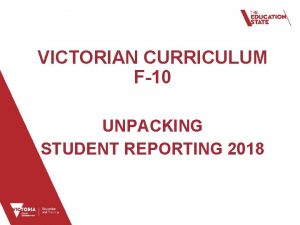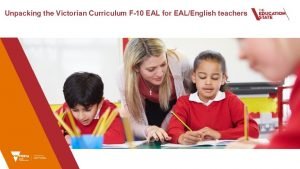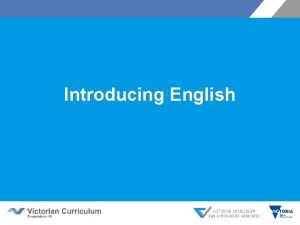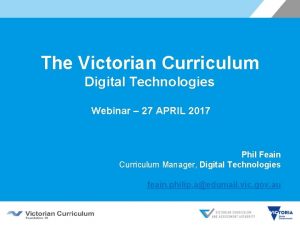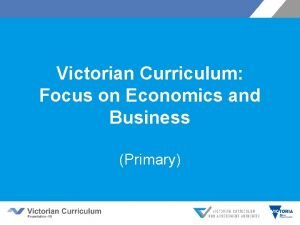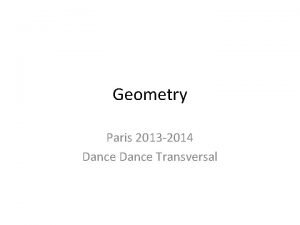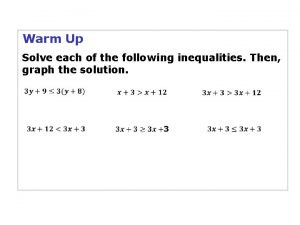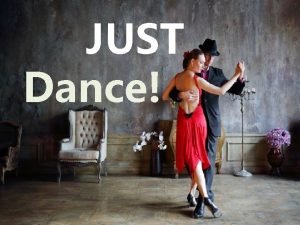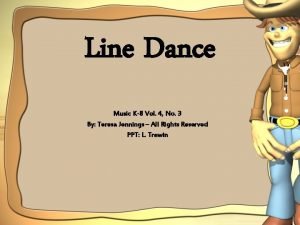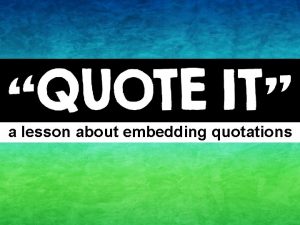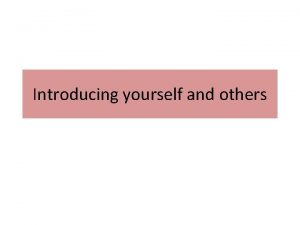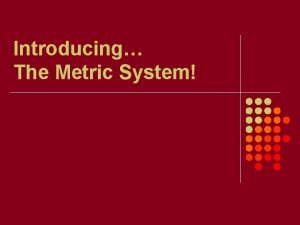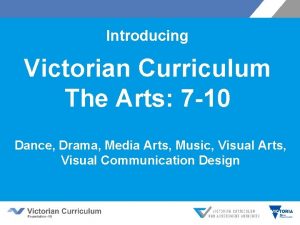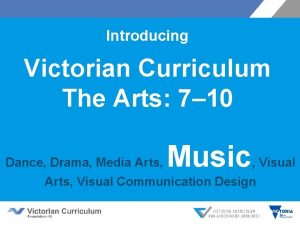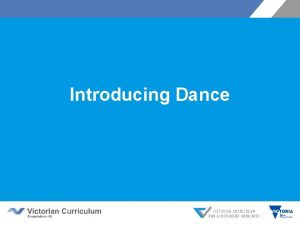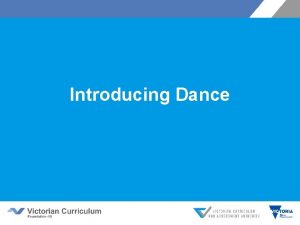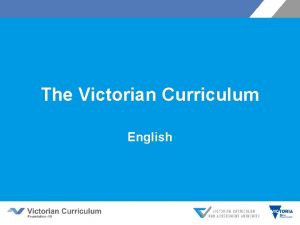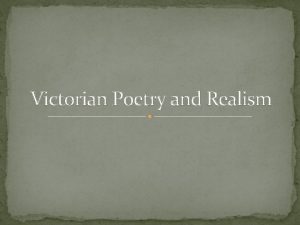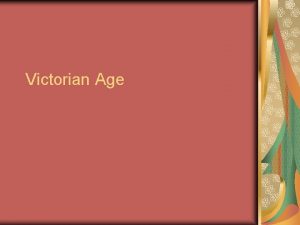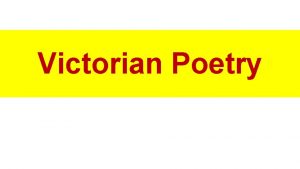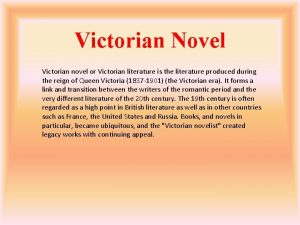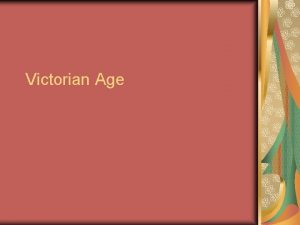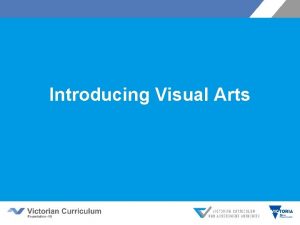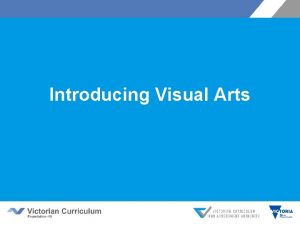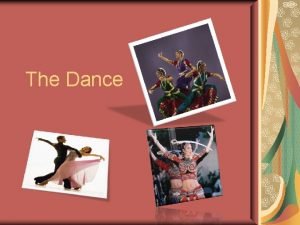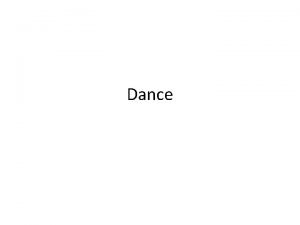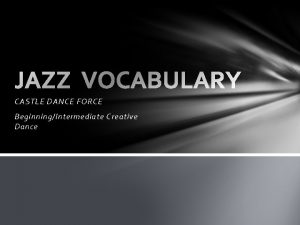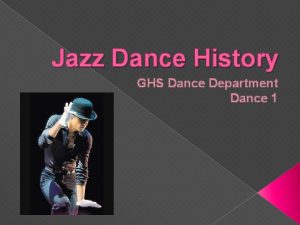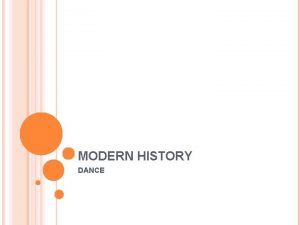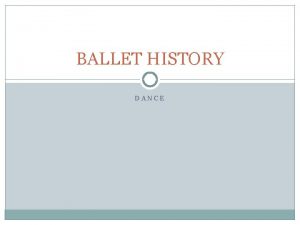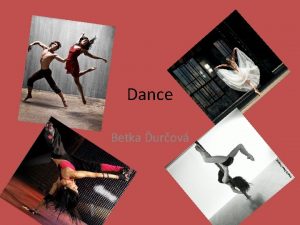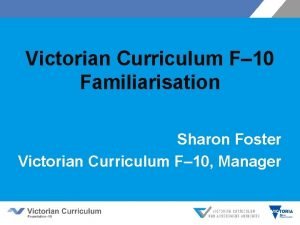Introducing Victorian Curriculum The Arts 7 10 Dance











































- Slides: 43

Introducing Victorian Curriculum The Arts: 7 -10 Dance, Drama, Media Arts, Music, Visual Arts, Visual Communication Design

Session overview • The Arts in the Victorian Curriculum • • Learning area structure Organising ideas Transition from Aus. VELS or Australian Curriculum Working with the curriculum • Curriculum planning for Arts learning • • Whole school, learning area, year level, units/sequences of learning Partnerships, incursions, excursions and residencies • Discipline overview: • Dance, Drama, Media Arts, Music, Visual Arts & Visual Communication Design • Key terms and phrases • • Range of … Viewpoints

Victorian Curriculum F– 10 • Released in September 2015 as a central component of the Education State • Provides a stable foundation for the development and implementation of whole-school teaching and learning programs • Victorian Curriculum F– 10 incorporates the Australian Curriculum and reflects Victorian priorities and standards

Victorian Curriculum Learning Areas Victorian Curriculum F-10 is represented as a continuum of learning The Arts • Dance • Drama • Media Arts • Music • Visual Arts • Visual Communication Design English Health and Physical Education The Humanities • History • Geography • Civics and Citizenship • Business and Economics Languages Mathematics Science Technologies • Design and Technologies • Digital Technologies Capabilities Critical and Creative Thinking Ethical Intercultural Personal and Social

The Arts in Victorian Curriculum One Learning Area that includes curriculum for six Arts disciplines that schools use to plan and deliver a teaching and learning program: F– 10 • • • 7– 10 • Dance Drama Media Arts Music Visual Arts Visual Communication Design

The Arts Curriculum F 1 -2 3 -4 5 -6 7 -8 9 -10 • The curriculum is represented on a continuum across 6 levels of achievement • An achievement standard is provided for each band • The Foundation (F) standard signifies the importance of The Arts in the early years of schooling • A curriculum to support students with a disability is provided and this is know as Towards Foundation Levels A-D

Level v Year • the curriculum should be regarded as a developmental continuum or progression of learning • schools and teachers are best placed to decide where on the continuum the focus of a learning program for a particular Arts discipline or a group of students should be positioned

Victorian Curriculum: The Arts 4 +2 Strands: • • explore & express/represent ideas practices present & perform respond & interpret Organising ideas: • students learn as artist and as audience • Students learn by making & responding

What’s happening now? How are The Arts delivered at your school through • Arts disciplines • Horizontal &/or vertical organisation • Inquiry learning • Whole school events or projects?

Common strand structure § Explore and Express Ideas Present and Perform Practices Respond and Interpret § The curriculum for each of the Arts disciplines uses a common structure with four interdependent strands, each involving making and responding This structure provides flexibility for schools to develop learning programs that § Are continuous or noncontinuous within a single discipline § Connect across learning areas or Arts disciplines

Learning as artist and audience Artwork Artist Audience responding and interpreting using imagination expressing/representing ideas presenting and performing techniques & processes using materials practicing skills instruments evaluation exploring thinking analysis media

Learning by making & responding making is informed by responding & responding informs making students learn as artist and as audience through making and responding

Take the web tour • Overview • Introduction • Using the view and filter options

Strand Sequence sample Explore & Express Ideas – Visual Arts Foundation L 1 & 2 L 3&4 L 5 & 6 L 7 & 8 L 9 & 10 Explore ideas, experiences, observations and imagination to create visual artworks. Explore ideas and artworks from different cultures and times to express ideas in visual artworks. Explore visual arts practices used by artists, to express different ideas and beliefs in artworks. Explore the practices used by artists to develop expressions of themes concepts or ideas in their own artworks. Explore the practices and styles of artists to develop their own personal style and express ideas and themes in their own artworks. Explore how artists use materials, techniques, technologies and processes to realise their own intentions in artworks. Explore how artists manipulate materials, techniques, technologies and processes to develop and express their own artistic intentions in artworks. Explore ideas, experiences, observations and imagination and express them in visual artworks.

Across the Arts Level 7 & 8 Dance Drama Media Arts Music Visual Arts Visual Communi cation Design Develop their choreographic intent by applying the elements of dance to select and organise movement Develop roles and characters consistent with situation, dramatic forms and performance styles to convey status, relationships and intentions Develop media representations to show familiar or shared social and cultural values and beliefs. Develop music ideas through improvisation, composition and performance, combining and manipulating the elements of music Explore how artists use materials, techniques, technologies and processes to realise their own intentions in artworks. Explore and apply methods, materials, media, design elements and design principles to create and present visual communication s Explore & Express Intentions, representations, elements, techniques, methods, materials.

Curriculum and resources Curriculum • • 2016 school choice between Aus. VELS and Victoria Curriculum F – 10 Victorian Curriculum F– 10 from 2017 Resources • • • General advice Specific Arts discipline advice Evolving Bookmark and check for updates Email ideas for updates http: //www. vcaa. vic. edu. au/Pages/foundation 10/f 10 index. aspx

Guidelines for including the Arts in a whole-school curriculum plan F-2 At the Foundation stage (Prep–Year 2), schools focus on five curriculum areas: English, Mathematics, The Arts, Health and Physical Education and Personal and Social Capability’. (p. 19). At these levels, substantial attention should be paid to the Arts. 3 -8 … an Arts program that in Years 3– 4 includes all five Arts disciplines and at Years 5– 6 and 7– 8 consists of at least two Arts disciplines, one from the Performing Arts and one from the Visual Arts. (p. 20) 9 -10 … An Arts program that includes in this band of schooling learning in at least one Arts discipline. The school curriculum plan should recognise that in these years of schooling some students begin to focus on areas of specialisation related to both their future schooling and intended pathways beyond school.

Developing Arts teaching and learning programs The common strand structure for each of the Arts discipline-specific curricula allows schools to continue to deliver The Arts through § learning programs that focus on one or more arts disciplines, for example, • • • a junior secondary program where students complete a semester of learning in each Arts discipline over 2 years a performing arts program with dance, drama and music components a visual arts program that focuses on 2 -d, 3 -d and 4 d forms a literacy program that draws on curriculum from English and Media Arts instrumental music § Project-based learning where Arts learning is aligned to themes, other learning areas or capabilities or inquiry questions, for example • • • work developed in other learning areas where an Arts form (film, play, song, dance) is used to communicate knowledge and understanding work developed with an artist-in-residence (physically or virtually) or local artist /s or arts organisation a celebration of school and community and identity expressed through dance, drama, media arts, music and visual arts presentations and performances created by the students in consultation with local Koorie elders and members of the community

Curriculum mapping • • Mapping identifies the extent of curriculum coverage in units of work and clearly links teaching, learning and assessment while working with the curriculum continuum. Mapping templates support teachers to identify where content descriptions and achievement standards are being explicitly addressed within the school’s teaching and learning program. Instructions: http: //www. vcaa. vic. edu. au/Pages/foundation 10/ viccurriculum/curriculumplanning. aspx Templates • For each Arts discipline • F-6 • 7 -10

Terminology • Band/Level descriptions • statements that provide an overview to the content descriptions and achievement standard within the level or band. • Strands • key organising elements within each curriculum area. • Content descriptions • specific and discrete information identifying what teachers are expected to teach and students are expected to learn. • Elaborations • non-mandated, advisory examples that provide guidance on how the curriculum may be transformed into a classroom activity or learning opportunity. • Achievement standards • statements that describe what students are typically able to understand, and are the basis for reporting student achievement.

Learning in: Dance practices § § § Choreography: the creative process of making dance Performing: practising, rehearsing, refining and applying physical and expressive techniques Appreciating: describing, explaining, evaluating and critically analysing their own dances and other dances they have viewed The elements of dance § space, time, dynamics and relationships are used in combination to create and communicate ideas and intentions through dance. Form § In Dance, form is the shape or structure of a dance according to a preconceived plan.

Learning as artist and audience in Dance performer choreographer audience exploring movement possibilities, responding to stimulus, improvising, interpreting, learning dances developing skills & techniques viewing, performing, reflecting, analysing, evaluating,

Learning In Dance Strand Explore and Express Ideas … exploring and shaping ideas … use imagination and responses to stimulii … and dance they have viewed … Dance Practices . . . choreography, performance and appreciation …build their movement vocabu lary and practise, skills, techniques and processes … Present and Perform Respond and Interpret … using physical and expressive skills and techniques in performance to communicate ideas and intentions to an audience… … reflecting, questioning and analysing as choreographer, performer and audience … engage with dance from diverse cultures, times and locations …

Dance in The Arts & HPE Dance is in The Arts and in Health and Physical Education § The two curricula are complementary § Students make and perform dances in both learning areas § § In the Arts, the focus is on the student as artist and audience and learning through choreography, performance and appreciation of dance and dance-making In Health and PE, the focus is on rhythmic and expressive movement activities with an emphasis on dance as a lifelong physical activity and the development of movement skills, concepts and patterns Together, The Arts: Dance and HPE provide ways for students to develop personal and social skills and critically appraise cultural and social factors that shape their own identities, body and communities.

Learning in: Drama practices Making • • • improvising, devising, playing, acting, directing, comparing and contrasting, refining, interpreting, scripting, practising, rehearsing, presenting and performing using movement and voice along with language and ideas to explore roles, characters, relationships and situations. shaping and structuring drama using contrast, juxtaposition, dramatic symbol, cause and effect, and linear and episodic plot forms. Responding • being audience members • listening to, enjoying, reflecting, analysing, appreciating and evaluating their own and others’ drama works. The elements of drama work dynamically together to create and focus dramatic action and dramatic meaning. Drama is conceived, organised and shaped by aspects of and combinations of role, character and relationships, situation, voice and movement, space and time, focus, tension, language, ideas and dramatic meaning, mood and atmosphere and symbol.

Learning as artist and audience in Drama performer designer drama-maker audience responding to stimulus, improvising, devising, interpreting scripts developing skills & techniques, applying stagecraft performing, viewing, reflecting, analysing, evaluating

Learning In: Drama Strand Explore and Express Ideas Drama Practices Present and Perform Respond and Interpret … imagining and . . . skills, techniques and processes for creating and sustaining characters, roles and situations in devised and scripted drama. … … applying acting, direction, design elements and stagecraft in performance spaces, rehearsing, and refining performances … … describing, reflecting, questioning, analy sing and evaluating as drama makers, designers, performers and audience… creating characters, roles and situations …dramatic play, role play, process drama … explore dramatic possibilities … http: //victoriancurriculum. vcaa. vic. edu. au/the-arts/drama/introduction/structure

Learning in: Media Arts Practices • In Making and Responding students engage with the key concepts, story principles and both technical and symbolic elements of media arts. • Making in Media Arts is the use of knowledge, skills, techniques, process and materials that communicate ideas and intentions. • Students design, produce and distribute media artworks. • Responding includes exploring, analysing and interpreting media artworks. • In making and responding to media artworks, students develop critical perception, personal expression and collaboration.

Victorian Curriculum Learning as artist and Audience/Viewer Artwork Artist on on i t n si tat e t In pres men Ex peri Ex Audience Contexts Institutions Exhibitions Performance Presentation Communication Representation

Learning in: Media Arts q Media forms: film, news reports, documentary, advertising, animation, music videos, video games, graphic novels and multimodal media arts forms. q Key media concepts: used to tell stories; technologies used to produce, access and distribute media; various institutions that enable and constrain media production and distribution; audiences; representation. q Technical and symbolic elements of media: including composition, space, time, movement, sound, colour and lighting for media forms in different contexts. q Story principles: structure, intent, characters, setting, points of view and genre. q Techniques and processes: pre-production, post production, distribution, engagement. q Materials: images, sound, text and technologies.

Learning In: Media Arts Strand Explore and Represent Ideas Media Practices Present and Perform Explore, investigate and experiment with ideas and develop characters, representations and viewpoints through characters, sound, settings, stories and text. Use media technologies and media conventions to create and represent stories in media forms. Planning, producing, distributing for specific audiences and contexts in media forms. Respond and Interpret … reflecting, questioning, analysing and evaluating as an audience and producer. …Identify specific features and purposes of media artworks.

Learning in: Music practices § listening, composing and performing § used separately and in combination § supported by additional activities § Using notation and ICT to record and communicate musical ideas; § reading, writing and interpreting § developing skills and techniques to discuss their own music and the music and music practices of others. The elements of music Musical ideas are conceived, organised and shaped by aspects and combinations of Rhythm, Pitch, Dynamics and expression, Form and structure, Timbre/tone colour & Texture.

Learning as artist and audience in Music performer composer listener singing, playing, composing, improvising, arranging, interpreting, developing skills & techniques, notating, recording, performing, reflecting, analysing, evaluating

Learning In: Music Strand Explore and Express Ideas Music Practices Present and Perform Respond and Interpret … planning, … exploring sound … skills, … reflecting, rehearsing and silence and techniques and questioning, and refining ways of using processes for analysing and performances to voice, body listening, evaluating as communicate percussion, composing and listeners, instruments and performing music ideas and composers and intentions to an technologies from diverse performers …develop and cultures, times and audience … voice, …listening skills to instruments, express locations… discriminate, technologies… ideas…listening identify … skills and imagination… http: //victoriancurriculum. vcaa. vic. edu. au/the-arts/music/introduction/structure

Learning in: Visual Arts Visual arts practices • The application of Arts skills and knowledge to create, represent, communicate and respond in a specific arts discipline, form, tradition, style and/or genre. • The practices of making and responding are interdependent and interactive. • The practices of interpreting, comparing and contrasting, reflecting, analysing, appreciating and evaluating can inform a making process but can also be used independently. • In Visual Arts the use of conceptual and practical processes in art making such as the use of sources of inspiration, exploration of ideas, exploration of and experimentation with materials and techniques, and the development and refinement of art works.

Learning in: Visual Arts q Focus on the practices of visual artists in different cultures, contexts and environments. Thinking, responding, making. q Viewpoints of responding and making artworks through the practices of the artist and the engagement of the audience. q Key ideas and issues in contemporary art practice that reflect beliefs and values of society. q Visual conventions: underlying structure of artworks. Style, art elements and art principles. q Materials, techniques and processes that are used in artistic practice.

Learning in: Visual Arts Strand Explore and Represent Ideas Media Practices Present and Perform Respond and Interpret Explore ideas, experiences, observations, imagination …. artworks and artists from different cultures and times. Experiment, select, apply Create and display artworks considering audiences, ideas and artists’ intentions and meaning. … reflecting, questioning, analysing and evaluating as a viewer and artist …Identify specific features and purposes of artworks from different periods of time and cultures. Materials, techniques, processes, technologies and visual conventions.

Learning in: Visual Communication Design • Present and Perform Developing and refining Visual Communication Designs for different audiences and purposes. Considering the relationship between designer’s intentions, audience characteristics and needs. • Respond and Interpret Analysing and evaluating Visual Communication Designs for different audiences and purposes in different contexts.

Learning In: Visual Communication Design • Visual Communication Design practice includes: • the use of design thinking skills • design as a process. Students respond to and write a brief, research and generate ideas, develop and refine visual communications. • Students communicate ideas and information through the use of: • drawing conventions – using a range of media, materials and methods to visualise ideas. • design elements and principles – such as line, shape, colour, tone, texture, form, type, balance, contrast, scale and hierarchy. • skills, techniques and processes – in a range of methods, materials, media and technologies

Learning In: Visual Communication Design Strand Explore and Represent Ideas Visual Communication Design Practices Explore and apply Use manual and methods, digital drawing materials and systems. media. Visual Create, develop Communication and present visual Presentation communication conventions in presentations. Industrial, Environmental and Communication Design. Present and Perform Respond and Interpret Visual Communication Presentations for different audience needs. …Identify, describe, analyse and evaluate Use of materials, methods, media Develop briefs for specific audiences. visual communication presentations in historical and cultural contexts.

Making choices about teaching materials No specific materials or stimulus is stipulated in The Arts curriculum When the curriculum mentions ‘across a range of styles, forms’ etc. teachers have the opportunity to choose teaching resources or stimulus materials that are relevant for their students. For example, teachers can make choices to ensure students experience Arts practices • typical of cultures that students identify with • that reflect the culture practiced by the indigenous people of the Country on which the school in situated, in consultation with the local Koorie, Aboriginal or Torres Strait Islander community • used by artists and arts organisations in the local community • typical of selected styles or practitioners • relevant to particular forms or ways of working

Education State goals, ambitions and targets Discuss the opportunities provided by the Education State target for The Arts Page 11: http: //www. education. vic. gov. au/Documents/about/educationstate/launch. pdf

Contacts Curriculum Manager: Performing Arts Helen Champion PH: 9032 1723 Email: champion. helen. h@edumail. vic. gov. au Curriculum Manager: Visual Arts Kathryn Hendy-Ekers PH: 9032 – 1697 Email: Hendy-Ekers. Kathryn. L@edumail. vic. gov. au
 Victorian curriculum art
Victorian curriculum art Victorian curriculum the arts
Victorian curriculum the arts Victorian curriculum visual arts scope and sequence
Victorian curriculum visual arts scope and sequence Dance curriculum victoria
Dance curriculum victoria Victorian curriculum dance
Victorian curriculum dance Dance dance dance in the freedom we know
Dance dance dance in the freedom we know English georgian floral design
English georgian floral design Ancient egyptian floral design
Ancient egyptian floral design Creative arts grade 7 lesson plans term 3
Creative arts grade 7 lesson plans term 3 Eal curriculum reporting tool
Eal curriculum reporting tool Intercultural capability vic curriculum
Intercultural capability vic curriculum Different types of dinosaurs
Different types of dinosaurs Hpe curriculum vic
Hpe curriculum vic Victorian curriculum economics
Victorian curriculum economics Victorian curriculum languages
Victorian curriculum languages Critical and creative thinking vic curriculum
Critical and creative thinking vic curriculum Progression points victorian curriculum english
Progression points victorian curriculum english Historical concepts and skills
Historical concepts and skills Victorian curriculum physical education
Victorian curriculum physical education Ethical capability meaning
Ethical capability meaning Victorian curriculum history
Victorian curriculum history Victorian curriculum technology
Victorian curriculum technology Victorian curriculum music
Victorian curriculum music Year 8 curriculum victoria
Year 8 curriculum victoria Victorian curriculum eal
Victorian curriculum eal Victorian curriculum japanese
Victorian curriculum japanese Vchpepe
Vchpepe Victorian curriculum eal
Victorian curriculum eal Victorian curriculum economics
Victorian curriculum economics English curriculum victoria
English curriculum victoria Victorian curriculum technology
Victorian curriculum technology Victorian curriculum economics and business
Victorian curriculum economics and business Dance dance transversal
Dance dance transversal Joan needed $100 to buy a graphing calculator
Joan needed $100 to buy a graphing calculator Madison line dance
Madison line dance Cm9iysdxagc -site:youtube.com
Cm9iysdxagc -site:youtube.com Everybody dance and sing line dance
Everybody dance and sing line dance Dance national curriculum
Dance national curriculum How to do quotes in mla format
How to do quotes in mla format Quote explanation starters
Quote explanation starters Introduce yourself
Introduce yourself Cs download illustrator
Cs download illustrator Introducing flex pods
Introducing flex pods Khdmdcm metric system
Khdmdcm metric system

